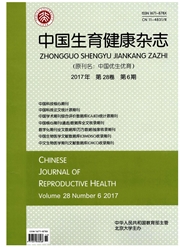

 中文摘要:
中文摘要:
目的 通过测量直接照料者的生命质量,对神经管畸形的无形负担进行定量描述. 方法 对37例NTDs患者进行日常生活能力评价,采用EQ-5D生命质量量表,测量神经管畸形患者直接照料者的生命质量.结果 37例神经管畸形患者直接照料者,在行动、自己照顾自己、日常活动3个方面均完全没有问题,62.2%的直接照料者表示有不同程度的焦虑或抑郁,32.4%的直接照料者表示有一些疼痛或不舒服.神经管畸形患者直接照料者健康指数均数为0.84、四分位数间距为0.28;EQ VAS健康分值均数为0.72、四分位数间距为0.15.未发现神经管畸形患者年龄、患者日常生活能力水平、直接照料者的年龄及其健康状况对直接照料者生命质量产生影响.结论 神经管畸形患者一定程度上影响了直接照料者的生命质量,反映了患者家庭所承担的无形负担.
 英文摘要:
英文摘要:
Objective To quantitatively describe the intangible burden of neural tube defects by measuring quality of life for caregivers of patients with neural tube defects.Methods Subjects were 37 patients with neural tube defects who were livebom during January 2000 and March 2012 and were alive at the follow-up during July and October 2012 in five counties of Shanxi Province.Face-to-face interviews were conducted with the caregivers of these patients.EQ-5D instrument was used to measure quality of life of the caregivers.Results Thirty-seven caregivers were interviewed.None of them had difficulty in mobility,self-care,and usual activities.However,62.2 % of them had different levels of anxiety or depression,and 32.4% had complaint of pain or discomfort.The mean of EQ-5D health index and visual analogue was 0.84 and 0.72,respectively; the quartile range of EQ-5D health index and visual analogue was 0.28 and 0.15,respectively.Age and activity of daily living of neural tube defects patients,as well as age and health status of the caregivers were not associated with quality of life of the caregivers.Conclusion Caring for patients with neural tube defects had negative impact on the quality of life for the caregivers,which reflects intangible burden of the patient's family.
 同期刊论文项目
同期刊论文项目
 同项目期刊论文
同项目期刊论文
 Levels of PAH-DNA adducts in placental tissue and the risk of fetal neural tube defects in a Chinese
Levels of PAH-DNA adducts in placental tissue and the risk of fetal neural tube defects in a Chinese Partner cigarette smoking and risk of neural tube defects among infants of non-smoking women in nort
Partner cigarette smoking and risk of neural tube defects among infants of non-smoking women in nort 期刊信息
期刊信息
